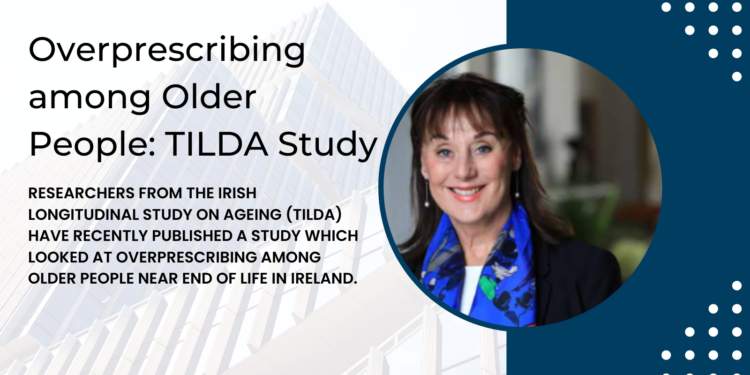Researchers from the Irish Longitudinal Study on Ageing (TILDA) have recently published a study which looked at overprescribing among older people near end of life in Ireland.
International evidence shows that people approaching end of life (EOL) have high prevalence of polypharmacy, including overprescribing. Overprescribing may have adverse side effects for mental and physical health and represents wasteful spending. Little is known about prescribing near EOL in Ireland. The study authors comprised of Soraya Matthews, Dr Frank Moriarty, Dr Mark Ward, Dr Anne Nolan, Professor Charles Nomand, Professor Rose Anne Kenny and Peter May. They aimed to describe the prevalence of two undesirable outcomes, and to identify factors associated with these outcomes: potentially questionable prescribing, and potentially inadequate prescribing, in the last year of life (LYOL).

They used The Irish Longitudinal Study on Ageing, a biennial nationally representative dataset on people aged 50+ in Ireland. Below we summarise their findings. In a nationally representative sample of 525 older people with high mortality risk in Ireland, 401 (76%) had potentially inadequate and 294 (56%) potentially questionable medications. Prevalence of these prescribing patterns among those in LYOL was 62% and 38% respectively. One factor was significantly associated with potentially inadequate medications in LYOL: male (OR 4.40, p = .004) Three factors were associated with potentially questionable medications in LYOL: male (OR 3.37, p = .002); three or more activities of daily living (ADLs) (OR 3.97, p = .003); and outpatient hospital visits (OR 1.03, p = .02). Comparatively lower prevalence of the specified prescribing patterns in LYOL is encouraging to the extent that they may indicate a level of deprescribing is occurring as people approach end of life.
However, approximately 30,000 people die annually in Ireland (the majority of them over the age of 50), and our data suggest that a large proportion of these are at risk of inappropriate polypharmacy. Tackling high prevalence of overprescribing near end of life requires ex ante identification of those at greatest risk. Multivariable regression results indicate that male sex is the strongest predictor of both undesirable outcomes. The odds of men receiving potentially inadequate medications were 4.4 times higher (than the odds of women receiving potentially inadequate medications), after controlling for other important predictors of prescribing.
Similarly, the odds of men receiving potentially questionable medications were 3.4 times higher (than the odds of women receiving questionable medications), after controlling for the same predictors. Three or more ADL difficulties and outpatient engagements were also associated with potentially questionable medications, but neither cancer nor cardiovascular disease were associated with outcome. Examining the prevalence of potentially inadequate and questionable medications among male and female participants, differences were noted across medications used in the prevention and treatment of cardiovascular disease (antiplatelet and anticoagulant drugs, lipid-lowering drugs), with higher prevalence among males, and to a lesser extent, higher prevalence of medication for osteoporosis among females.
These patterns are reflective of the patterns of prescribing observed in middle-aged and older adults more generally, with noted undertreatment of women compared to men given the same level of cardiovascular morbidity, while older men with similar risk of fracture to women are less likely to be treated for osteoporosis. This suggests that being of high mortality risk does little to reduce the disparity in prescribing between sexes. There were also high rates of medical or GP visit card eligibility (based on income) among those with questionable or inadequate medications, potentially reflecting an impact of higher burden and severity of co-morbidities, or greater access to care. Much of the existing literature on inappropriate prescribing among people with limited life expectancy has focussed on where the likely benefits will not be realised within a patient’s life expectancy. Most studies have focussed on people with a specific life-limiting condition, most often cancer.
The most often cited preventive medications prescribed inappropriately were lipid-lowering drugs and antihypertensives, similar to the findings of our study, as well as antidiabetic drugs, which had a relatively low prevalence in the current study. Often such medications are only stopped in the last month of life. This underlines the importance of reviewing and discussing the need and benefit of such long-term medications to align treatment with patients’ goals, in general but particularly among people with life-limiting illness. It is also worth noting that while overprescribing is the focus of much research on optimal medication use near end of life, under prescribing is also an important issue, where use of symptom-relieving medications that enhance quality of life may be insufficient.
Care for such patients should focus not just on reducing medications, but ensure therapy maximises quality and quantity of life and is aligned with patient priorities. Ireland is ranked fourth worldwide for end-of-life care, meaning that there is relatively high per capita palliative care provision at the population level. Our paper highlights that even in a setting with well-established palliative care services, the risk of inappropriate prescribing among people with limited life expectancy in significant.
However, these deficiencies in patient experience must be understood in the context of other challenges; previous research in TILDA demonstrated strong evidence for undermanagement of illness symptoms near end of life, whereas overprescribing is a form of overtreatment. Thousands of older people die annually in Ireland with potentially inappropriate or questionable prescribing patterns. Gender differences for these outcomes are very large. Further work is needed to identify and reduce overprescribing near EOL in Ireland, particularly among men.
Read our Latest News
Read the IPN Janauary Magazine










